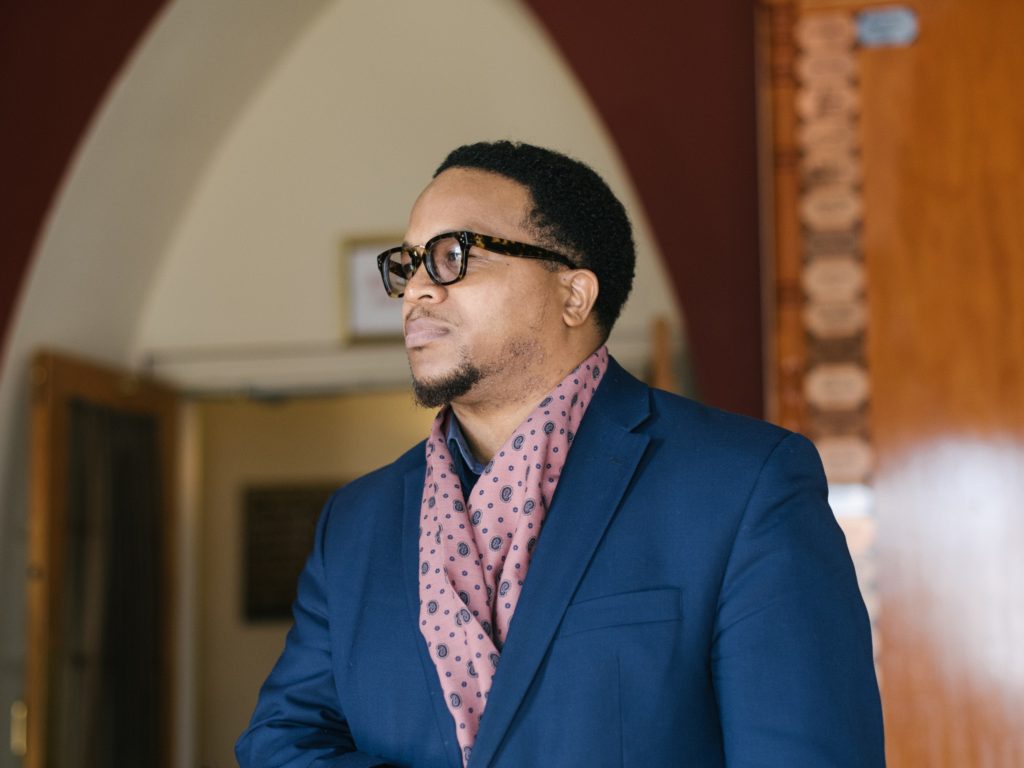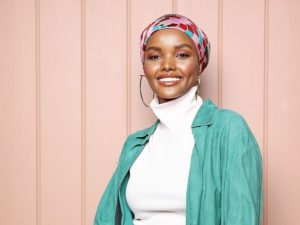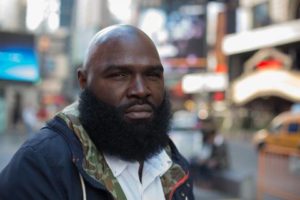Bowties, Beards, and Boubous: Black Muslim Men’s Fashion in the United States
How Black Muslim men's clothing reflects their religious beliefs and influences the broader culture

Above image: Idris Abdul-Zahir, an Imam in Philadelphia, Pennsylvania. (Photo by Hannah Yoom). Main article thumbnail image: Mobalaji Akintunde in a photoshoot for Su’ad Abdul Khabeer’s “The Style/Muslim Dandy Project.” (Photo by Evan Brown).
Walking down West 116th Street in Harlem is one of my favorite activities. As I carry my large haul of wax print scarves and maxi skirts that I bought from the Malcolm Shabazz Harlem Market, an open-air market filled primarily with West African and Black American vendors, old-heads in kufis and track suits, young men in smart suits, and middle-aged men wearing boubous that billow with the wind catch my attention. They offer me smiles and friendly “salaams” and go about their day. This is what Black Islam looks like in the United States and what I have been studying for the past seven years. Yet, from media representations, you would think Black Muslim men and their diverse fashion sense did not exist.
Men who look like the ones I interact with in Harlem, Philadelphia, and Chicago do not make it onto the silver screen as the representatives of Islam; that is almost exclusively reserved for non-Black Arab men with beards and thobes. In the United States, Islam is often depicted as a foreign religion and Muslims are the ultimate “Other.” Black Muslims, especially those who descend from enslaved Africans throw a wrench in this narrative. For many cultural producers, it is easier to erase Black Muslims and their cultural and sartorial diversity than to provide an inclusive representation of Islam in the United States. Black Muslims push back against this erasure that happens in the media, as well as in their everyday lives from the mosques to the streets by using fashion.

Halima Aden
Research on fashion often centers on women’s dress practices. In part, this is because fashion is gendered, primarily considered a women’s domain. This is especially true when discussing Muslims’ dress practices. Much media attention has been paid to the hijab, which is positioned as the most visible symbol of Islam. These discussions often focus on Muslim women’s motivations for dressing modestly and on interpretations of religious texts. Popular media accounts of Muslim women’s dress tend to lean towards Orientalist depictions of the hijab, primarily focusing on descriptions of dress and comparisons with other religions, and even before and after pictures with former hijabis. The rise of covered Muslim mainstream models like Halima Aden and Kadija Diawara has led to more nuanced conversations among journalists and scholars about modesty, women’s fashion, and ethnicity. However, much work is left to be done to explore Muslim men’s dress practices.
In what follows, I provide an overview of three dress practices that I observed while conducting research for my forthcoming book, Fashioning Black Islam: Race, Gender, and Belonging in the American Ummah, in Chicago, Philadelphia, and New York City. All three cities have large Black Muslim populations and have played a central role in the spread of Islam in the United States. Contemporary Black Muslim communities in Chicago, Philadelphia, and New York can be traced back to the early 1920s with the arrival of Ahmadiyya missionaries, the emergence of Black new religious movements including the Moorish Science Temple of America and the Nation of Islam, and the growth of Black Sunni communities. While bowties, beards, and boubous can be found outside of these locales, these three cities helped popularize these styles in America.
While suits, beards, and tunic robes like boubous are worn by Black non-Muslims and non-Black Muslims, these styles play an important role in creating and maintaining Black Muslim men’s religio-racial identity. While these dress and adornment practices did not all originate from Black people, as cultural studies scholar Robin G. Kelley observes, there is a Black way of doing things. The story of Black Muslim men’s fashion reflects the various migration and immigration patterns and theological plurality that makes the American Muslim community one of the most diverse in the world.
Bowties
In 2019 in Chicago, I attended Saviour’s Day, an annual event hosted by the Louis Farrakhan-led Nation of Islam (NOI) that commemorates the birth of W.D. Fard Muhammad, the founder of the organization. I was showered with “As-salam alaikums, my sister” by Black men in sharp suits in browns, blues, and greys, a mix of solid colors and pinstripes. Their stylish ties and bowties matched their pocket squares. Most had tapered haircuts and clean-shaven faces, save for a few well-groomed mustaches. To an outsider, the men probably looked like they were on their way to a business conference, rather than a religious event. Nothing they wore could be easily read by non-Muslims as “Islamic” except their lapel pins, which included a red crescent moon and the phrase “In the name of Allah.” While few if any of these men would self-identify with the term, “Muslim dandy,” a term anthropologist Su’ad Abdul Khabeer introduced me to that describes their styles as a “sign of heterosexual masculine maturity”.
Muslim dandyism should not be understood as a mere appropriation of white middle-class aesthetics. Rather, as Africana studies scholar Monica L. Miller writes, dandyism is a signifying practice, “a strategy of survival and transcendence.” For members of the Nation of Islam, the suit is a physical representation of their membership in the organization and their spiritual transformation from one of the “living dead” to a Muslim. Founded in Detroit in 1930, the Nation of Islam sought to provide Black people with a new sense of self that challenged white supremacist representations of Blackness. For Black men, this meant challenging images of them as lazy, hypersexual, feminine, and poor providers or protectors of Black women.
Many of the Nation’s pioneers were poor and working-class Southern migrants and Caribbean immigrants. They existed outside of both white expectations of masculinity and Black middle-class norms. For men in the Nation of Islam, a well-tailored suit became a disciplining tool that signaled to others that they are “civilized” and reminded them to act “civilized,” which meant avoiding taboo activities like smoking and gambling, practicing proper gender segregation, and being willing to defend Muslim women. The Nation of Islam used the term “civilized” to describe their original state before colonization and enslavement. It reflects the ways the Nation of Islam appropriated and reworked white supremacist logics, where Black people are reimagined as at the top of the racial hierarchy. Through wearing suits and bowties, male members distanced themselves from racist images of rural poverty and criminality linked to Black urban culture so they could embrace Black respectability. Today, the suit and bowtie remain important aspects of the Nation of Islam’s image. Along with selling the Nation of Islam’s official journal, Final Call, wearing suits is an important fishing, or recruitment, tool because it provides men with a visual example of new social, political, and religious possibilities.
Beards
While beards can be found throughout various Muslim communities in the United States, Philadelphia stands as one of the homes of the “Sunnah beard” because of its rich cultural influence in Black America among Muslims and non-Muslims alike. One of the most famous wearers of the Sunnah beard, also known as the Philly beard, is rapper Freeway. The rapper wears a beard because he believes it is Sunnah, the ways of Prophet Muhammad, who according to Tradition had a long beard. As Islamic studies scholar Amanullah De Sondy notes, early Muslims positioned beards as a means of communicating masculinity and heterosexuality. The Qur’an is silent on the subject, but several hadiths provide details about men’s facial hair.
 A hadith collected by Al-Bukhari narrated by Ibn Umar states that Muhammad said, “Cut the moustaches short and leave the beard.” The Philly beard tends to follow this, with wearers keeping a low moustache (or no moustache at all) and a full beard. Philly beard wearers often comb out their beards to lengthen them. Barber Atif Oberlton explains what makes the Philly beard different from other styles: “Really, a Philly Beard is just made up of the fullness and the thickness and the hair that they had come down and the way that it hangs. It’s extra thick where it hangs down.” As Brian L. Coleman notes, class plays a role in determining who is more likely to wear it and connect it to religious belief. He found that middle-class Black converts were less likely to wear beards than working class men.
A hadith collected by Al-Bukhari narrated by Ibn Umar states that Muhammad said, “Cut the moustaches short and leave the beard.” The Philly beard tends to follow this, with wearers keeping a low moustache (or no moustache at all) and a full beard. Philly beard wearers often comb out their beards to lengthen them. Barber Atif Oberlton explains what makes the Philly beard different from other styles: “Really, a Philly Beard is just made up of the fullness and the thickness and the hair that they had come down and the way that it hangs. It’s extra thick where it hangs down.” As Brian L. Coleman notes, class plays a role in determining who is more likely to wear it and connect it to religious belief. He found that middle-class Black converts were less likely to wear beards than working class men.
The Philly beard is also a popular style outside of Black Muslim communities and is worn by several Black non-Muslim celebrities including Lebron James and Rick Ross. Often, the only way one can tell which Philly beard wearer is a Muslim is to wait for him to offer “salaams.” One explanation for the popularity of the Philly beard is the relationship between Islam, hip hop, and Blackness dating back to its origins in the South Bronx in the 1970s. The Last Poets, who are considered a “precursor to the hip hop emcee,” were formed on Malcolm X’s birthday three years after his assassination and were either Muslim or heavily influenced by Black Islam. As Hisham Aidi points out, in Philadelphia Black Islam’s relationship to music extends to jazz, soul, and R&B, thereby spreading Muslims’ cultural influence to a wider audience. Journalist Corey Townes argues that outside of hip hop, the Philly beard spread to Black non-Muslims as a result of mass incarceration. Incarcerated men were introduced to Islam and interacted with Muslims, some of whom wore long well-groomed beards. Even if they chose not to convert, many Black men picked up the style and the practice stuck. Like suits and bowties, beards are a form of Black (Muslim) cool. Regardless of the wearers’ religious background, the Philly beard represents Black masculinity, maturity, and individuality.
Boubou
The Immigration and Nationality Act of 1965 ended the racist immigration quota system that limited the number of immigrants from outside of Western Europe. This led to increased immigration of Muslims from Asia and Africa. Beginning in the late 1980s and early 1990s, many West Africans from Francophone countries emigrated to Harlem, which is known as a Black cultural center and has a long history of Black Islam. West African immigrants’ arrival in Harlem led to increased inter-ethnic dialogue, and at times tension, about Africa and Blackness among immigrants and older Black communities.
Walking down 116th Street in Harlem, men wearing boubous are as common a sight as joggers and suits, especially on and around Shaykh Amadou Bamba Day, which reflects the ethnic and religious diversity of Harlem. The boubou is a long ankle-length loose-fitting robe that is both everyday and formal wear and can be found throughout West Africa, Central Africa, and their respective diasporas. While boubous are worn by all genders, there are subtle differences: men’s boubous often have a V-neck and matching pants and shirt. Fashion studies scholar Leslie Rabine writes, “When stiffly starched and draped over the body, the boubou creates for its wearer the appearance of a stately, elegant carriage with majestic height and presence.”
 For members of the Sufi Muslim order Mourides, a group founded by Shakyh Amadou Bamba in Senegal in 1883, wearing a boubou provides a means of asserting a distinct religious identity in a secular space where there are competing definitions of Muslimness and Blackness. The boubou sartorially differentiates Senegalese Muslims from their Black American, Caribbean, and Latinx counterparts. The boubou’s presence on the streets of Harlem temporarily transforms the space into a Sufi Senegalese environment and plays a key role in creating “Little Senegal” on West 116th Street. Like the Nation of Islam’s bowtie and suit, the boubou also represents a challenge to what I call “hegemonic Islam,” which privileges Arab cultural practices as the most authentic. Hegemonic Islam also extends to dress.
For members of the Sufi Muslim order Mourides, a group founded by Shakyh Amadou Bamba in Senegal in 1883, wearing a boubou provides a means of asserting a distinct religious identity in a secular space where there are competing definitions of Muslimness and Blackness. The boubou sartorially differentiates Senegalese Muslims from their Black American, Caribbean, and Latinx counterparts. The boubou’s presence on the streets of Harlem temporarily transforms the space into a Sufi Senegalese environment and plays a key role in creating “Little Senegal” on West 116th Street. Like the Nation of Islam’s bowtie and suit, the boubou also represents a challenge to what I call “hegemonic Islam,” which privileges Arab cultural practices as the most authentic. Hegemonic Islam also extends to dress.
While the American Muslim community is perhaps one of the most diverse in the world, with no one race or ethnicity representing a majority, some groups are privileged over others: primarily Arabs and to a lesser extent, South Asians. Su’ad Abdul Khabeer argues that some Muslims embrace what she calls “the politics of pious respectability,” believing that the more Islamic knowledge they gain, the more a Muslim will aesthetically shift towards the “Islamic East” where “authentic” Islam resides. Embracing an imagined Islamic East often means sartorially rejecting Blackness. Yet, according to the Tradition in Prophet Muhammad’s Farewell Sermon he insisted that “No Arab has any superiority over a non-Arab, nor does a non-Arab have any superiority over an Arab.” For Senegalese Mouride men, wearing a boubou on the streets of Harlem communicates that their Blackness, Africanness, and Muslimness are interconnected.
***
As someone who studies fashion and Islam, one of my favorite hadiths is “Allah is beautiful, and he loves beauty.” This extends to men. To be clean and well-groomed is a religious expectation for all Muslims with the means to do so. How this is practiced varies based on race, ethnicity, age, and location. In their own ways, each style – bowties, beards, and boubous – also embodies Black cultural norms of looking good and wanting “to see and be seen.” For Black Muslim men, their style choices reflect their racial, religious, and political identities.
Like their female counterparts, Black Muslim men must navigate both white supremacist and Arab-centric assumptions about gender, race, and religion where Black Muslimness is often positioned as less authentically Muslim. Their clothing and natural bodily adornments become an important way for them to push back against their erasure and marginalization. At the same time, for Black Muslims, looking good is not solely about resisting white or Arab-Muslim gazes. It is also an expression of Black creativity and cool.
Kayla Renée Wheeler is an Assistant Professor of Gender and Diversity Studies at Xavier University. She is an expert in contemporary Black Islam and is currently writing a book on the history of Black Muslim fashion in the United States beginning in the 1930s.
***
Published with support from the Henry R. Luce Initiative on Religion in International Affairs.